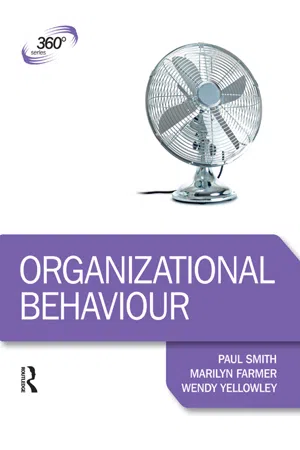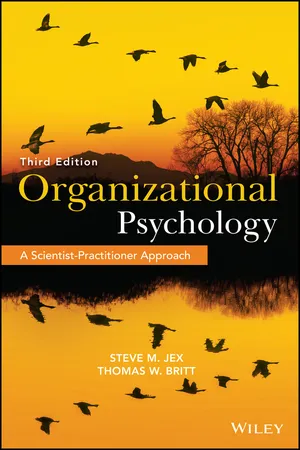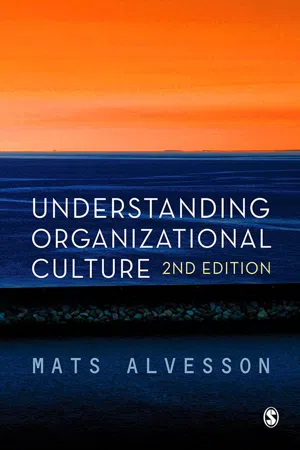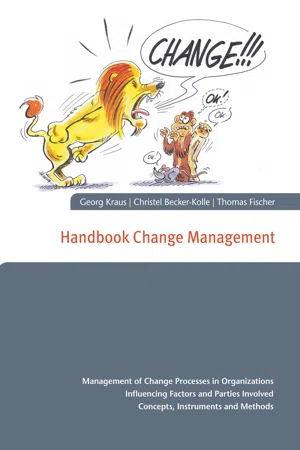Business
Organizational Culture Definition
Organizational culture refers to the shared values, beliefs, and behaviors that shape the unique social and psychological environment within a company. It encompasses the company's mission, vision, and core principles, as well as the way employees interact and work together. A strong organizational culture can enhance employee engagement, productivity, and overall business performance.
Written by Perlego with AI-assistance
Related key terms
Related key terms
1 of 4
Related key terms
1 of 3
11 Key excerpts on "Organizational Culture Definition"
- eBook - ePub
Multigenerational Communication in Organizations
Insights from the Workplace
- Michael G. Strawser, Stephanie A. Smith, Bridget Rubenking(Authors)
- 2021(Publication Date)
- Routledge(Publisher)
5 Perspectives on Organizational CultureThe remainder of the volume hinges on this chapter as the foundational component of the workplace. Organizational culture will be defined and presented within a historical context; then the authors will reflect on their findings and connect these findings to previous literature.5.1 Defining Organizational Culture
2020 arguably changed many personal and professional elements of the workplace. For one, suddenly, more than ever before, organizations were under attack for their values or lack thereof. As organizations learned to pivot, downsize, re-establish values, and communicate with various stakeholders, society at large was not the only group experiencing change. Organizations were under a cultural attack in many ways and were forced to reconsider all elements of the business, which collectively contribute to an organization’s culture.Organizational culture is a saturated area of study in management, business, and communication industries. Therefore, the definition of organizational culture can be complex and varied. Typically, organizational culture is defined as a set of values, beliefs, assumptions, and symbols that define the way in which a firm conducts its business (Deal & Kennedy, 1982 ). Organizational culture is important because it identifies the relevant employees, customers, suppliers, and competitors and defines how an organization will interact with these parties. Organizational culture has been correlated with competitive advantage (Barney, 1986 ), leadership (Schein, 2010 ), recruitment (Braddy, Meade, & Kroustalis, 2006 ), retention (Sheridan, 1992 ), and unethical behavior (Umphress, Bingham, & Mitchell, 2010 ), to name a few.Organizational culture helps us understand exactly how organizations accomplish goals and fulfill their missions and purposes (Sanchez, 2011 ). Culture is anecdotally referred to as “the way things are done around here,” similar to hearing “because I said so” from a parent while you were growing up. Organizational culture can seem arbitrary, but it is nonetheless pragmatic as defined by Trompenaars and Hampden-Turner (1997) - eBook - ePub
- Paul Smith, Marilyn Farmer, Wendy Yellowley(Authors)
- 2013(Publication Date)
- Routledge(Publisher)
A classic definition is provided by Deal and Kennedy (1982), who suggest that culture is ‘the way we do things around here’. This definition captures the concept, as organizational culture is all about attitudes, values and beliefs that employees share. Although the focus of Hofstede's (1984) work was the wider culture in society, his definition of national culture highlights the critical aspect of ‘learning’ in relation to culture: ‘a body of learned behaviour, a collection of beliefs, habits and traditions, shared by a group of people and learned by people’. New recruits to an organization have to ‘learn’ the ways of behaving and must partially accept this or leave.Culture is sometimes seen as something that binds people together – for example, ‘organizational culture can be thought of as glue that holds an organization together through a sharing of patterns of meaning. The culture focuses on the values, beliefs, and expectations that members come to share’ (Siehl and Martin 1984, cited in Butler and Rose 2011: 353).Culture has a vital role to play in organizations, as it moulds and shapes the way that people behave, both internally and with the external environment, which includes customers and stakeholders. Yet culture is difficult to explain because it is rather like jelly – it is moulded and set, but it is a struggle to grasp it. Another complication with the concept is that organizations do not employ people to become automatons and all act the same, but they do expect employees to conform.In summary, culture is a vehicle through which an organization's identity emerges in terms of what it stands for, how employees should behave and what it believes in.Another way to think about organization culture has been put forward by Schein (1992, cited in Knights and Willmott 2007), in the form of an iceberg, which has only a relatively small part of its total mass visible above the water. Using this metaphor, some elements of culture can be seen and are easily accessible. Other elements of culture are hidden beneath the surface, often not written down and become apparent only once an employee is socialized into the way of working. - eBook - ePub
Organizational Psychology
A Scientist-Practitioner Approach
- Steve M. Jex, Thomas W. Britt(Authors)
- 2014(Publication Date)
- Wiley(Publisher)
Over the years many definitions of organizational culture have been put forth in the organizational psychology literature (e.g., Louis, 1983; Martin, 2002). Fortunately, however, most of these have a great deal in common. In an effort to integrate these various definitions, Schein (2010) stated that culture is “a patterned set of basic assumptions learned by a group as it solved its problems of external adaptation and internal integration, which has worked well enough to be considered valid and, therefore, to be taught to new members as the correct way to perceive, think, and feel in relation to those problems” (p. 18). This is obviously a lengthy definition, but there are two important things to take away from it. First, this definition implies that culture is the “view of the world” that is shared by the members of an organization and passed on to new members as they enter the organization. In essence, culture represents the “lens” through which employees of an organization learn to interpret the environment. Second, and perhaps most important, this definition implies that cultures do not develop randomly; rather, they serve a purpose. Cultures help organizations adapt to their external environment, and by doing that, promote survival. Culture also represents the force that keeps people within an organization working toward a common goal rather than simply going off in different directions. According to Schein (1985 1992), there are three levels of an organization's culture, and each succeeding level is more difficult for outsiders to decipher. The most visible level of organizational culture is reflected in artifacts, technology, and behavior patterns. Artifacts, which will be discussed in more depth later, are aspects of the physical environment that communicate cultural meaning. Technology represents the means by which organizations transform input from the outside environment. Behavior patterns, of course, simply represent what employees in the organization do.The next level of culture, according to Schein (1992), is represented by the shared values within the organization. Values simply represent individuals' broad tendencies to prefer certain things, or states of affairs, over others (Hofstede, 1980). Values that might be salient within an organization could be a number of things: loyalty, customer service, collegiality, and self-preservation, to name a few. According to Schein (1992), values are less accessible to an outsider than are things such as behavior patterns, and, typically, they must be inferred by the outsider through symbolic means. For example, if an organization rewards and promotes employees largely on the basis of seniority, one might infer that the organization tends to place a high value on loyalty and retention. - eBook - ePub
Corporate Assessment (Routledge Revivals)
Auditing a Company's Personality
- Adrian Furnham, Barrie Gunter(Authors)
- 2015(Publication Date)
- Routledge(Publisher)
p. 181 )This definition is well rehearsed, but Eldridge and others have attempted to produce a clearer, more comprehensive definition. Thus Crombie (1974) noted:Culture … is a characteristic of all organizations through which, at the same time, their individuality and uniqueness is expressed. The culture of an organization refers to the unique configuration of norms, values, beliefs, ways of behaving and so on that characterize the manner in which groups and individuals combine to get things done. The distinctiveness of a particular organization is intimately bound up with its history and the character-building effects of past decisions and past leaders. It is manifested in the folkways, mores, and the ideology to which members defer, as well as in the strategic choices made by the organization as a whole. The individuality or cultural distinctiveness of an organization is attained through the more or less constant exercise of choice, in all sections and levels … The character of organizational choice is one of the major manifestations of organizational culture.(pp. 89 –90 )Eldridge and Crombie (1974) drew attention to three dimensions of culture, following the work of Angyal: depth, or vertical dimension; breadth, or lateral co-ordination of the contributing parts; and the progression dimension, which refers to co-ordination through time. They elaborated as follows:The depth dimension is exemplified in the formulation and adoption of policies, programmes, procedures and practices that represent the basic values and strategic commitments of the organization as a whole – the inducement of behaviour at the ‘surface’, in the day-to-day organization functioning.(p. 96 )The construct of culture has caused much confusion. While there are multiple definitions, they tend to be vague and overly general. This confusion is exacerbated by the various disciplines interested in this topic (anthropology, sociology, psychology) which while increasing richness, do not necessarily increase clarity. Hence, occupational psychologists and organizational behaviour specialists could be accused of ‘muddying the waters’, rather than disambiguating the concept. - eBook - ePub
Introduction to Human Resource Management
A Guide to HR in Practice
- Charles Leatherbarrow, Janet Fletcher(Authors)
- 2018(Publication Date)
- CIPD - Kogan Page(Publisher)
02Aspects of organisational culture
After studying this chapter, you should be able to:LEARNING OBJECTIVES
- understand the concept of culture, values and norms;
- demonstrate an understanding of how history, corporate climate, managerial style and other factors contribute to organisation culture;
- recognise the importance of culture as a determinant of workplace behaviour;
- understand that physical culture can act as a powerful means of creating identity within organisations;
- understand and be able to take account of your organisation’s culture in your role as an HR practitioner.
What is culture?
In 1871, the anthropologist Edward Tylor defined culture as ‘knowledge, belief, art, morals, law, custom and any other capabilities and habits acquired through membership of society’. In a narrower sense the term is used to describe the differences between one society and another. In this context, according to Giddens:(Giddens, 1989, p30)A culture is an all-pervasive system of beliefs and behaviours transmitted socially. Specifically, it consists of the sets of values and norms or rules held by a society, together with its material expressions.KEY CONCEPT: VALUES
A value is an ideal to which an individual subscribes. Values are learnt during the socialisation process. Individuals adopt them from the values of the society to which they belong; values have an influence on behaviour. Cultural values, as defined by Schwartz (2007, p25):Represent the implicitly or explicitly shared abstract ideas about what is good, right, and desirable in a society (Williams, 1970). These cultural values (eg freedom, prosperity, security) are the bases for the specific norms that tell people what is appropriate in various situations. - eBook - ePub
- Mats Alvesson(Author)
- 2012(Publication Date)
- SAGE Publications Ltd(Publisher)
1The Concept of Organizational Culture
Organizational culture is one of the major issues in academic research and education, in organization theory as well as in management practice. There are good reasons for this: the cultural dimension is central in all aspects of organizational life. Even in those organizations where cultural issues receive little explicit attention, how people in a company think, feel, value and act is guided by ideas, meanings and beliefs of a cultural (socially shared) nature. Whether managers think that culture is too soft or too complicated to bother about or whether there is no unique corporate culture does not reduce the significance of culture. Senior organizational members are always, in one way or another, ‘managing culture’ – underscoring what is important and what is less so and framing how the corporate world should be understood. Organizations practising intensive ‘numbers management’ may develop and reproduce a culture celebrating performance indicators and rituals around the handling of these. In most contemporary organizations, corporate culture receives a lot of attention and is seen as crucial. A key concern is that ‘culture management aspires to intervene in and regulate being, so that there is no distance between individuals’ purposes and those of the organization for which they work’ (Grey, 2005: 68).However, even in those cases where top managers have a strong awareness of the significance of culture, there is often a lack of a deeper understanding of how people and organizations function in terms of culture. High ambitions in attaining cultural control are seldom fully realized. Culture is as significant and complex as it is difficult to understand and ‘use’ in a thoughtful way. Awareness of and interest in culture vary between managers and companies. It is often difficult to attain a high level of cultural awareness to guide actions. The interest in quick fixes in much management writing and thinking is unhelpful. Instead a well-elaborated framework and a vocabulary in which core concepts – culture, meaning, symbolism – are sorted out are necessary for understanding and for qualified organizational practice by consultants, managers and others. - eBook - ePub
Handbook Change Management
Management of Change Processes in Organizations Influencing Factors and Parties Involved Concepts, Instruments and Methods
- Georg Kraus, Christel Becker-Kolle, Thomas Fischer(Authors)
- 2017(Publication Date)
- Books on Demand(Publisher)
6 Organizational culture / corporate cultureThe terms organizational culture, corporate culture, corporate mission statement, work climate, or organizational climate are often used to describe similar or the same contents. The following thoughts refer to organizational culture and corporate culture in a narrower context. Following these observations will be an overview of the corporate mission and mission statement.6.1 Developing awareness of organizational culture / corporate culture
At the beginning of the 20th century, Max Weber outlined an ideal bureaucratic organization with formal characteristics such as competency profiles, communication styles, and organizational types.He states that the purpose of an organization is to hold together all individual characteristics. Today, the power of energy fields, environmental impacts, and cybernetic systems has been added to these organizational models.For the past 40 years, grave differences have been observed when comparing the efficiency of organizations in different nations. Socio-cultural differences were identified, as in the comparison of Japanese and American companies, for example. These differences cannot, however, simply be summed up as one factor, namely that of corporate culture. The aspects of corporate culture that contribute to the success of an organization cannot be viewed independently from other cultural conditions. For example, some of the most relevant and useful norms that lead to success in Japan might cause serious chaos in the social fabric in Europe or the United States.During the 1980s, interest in organizational culture rose due to the research in social psychology and management. Knowledge about system theory and the complex interaction of social factors in groups added to the focus on group processes.The wide field of communication has a great deal of influence on the aspects of an organization and its approaches and processes, its roles, and its interactions. It is the simplification of the complexity of events that are illustrated in communication, which is a linear process. Issues in communication, which result from different professions, hierarchies, or roles, are also the topic of research reports and practical experiences from management development. - eBook - ePub
Organizational Climate and Culture
An Introduction to Theory, Research, and Practice
- Mark G. Ehrhart, Benjamin Schneider, William H. Macey(Authors)
- 2013(Publication Date)
- Routledge(Publisher)
are (Smircich, 1983). From the “organizations have cultures” perspective (or the objectivistfunctionalist view; Alvesson, 1993), researchers view culture as an organizational variable or attribute that is affected by and affects other organizational variables. The interest is usually functionalist, trying to understand how culture is linked to outcomes and effectiveness and thus how it can be changed to make the organization more efficient and more productive (Davey & Symon, 2001). Alvesson (1993) described this approach in terms of its technical interest, such that the goal is the development of understanding and knowledge of causal relationships to manipulate or control them to achieve desired outcomes (see also O’Reilly & Chatman, 1996). In this approach, organizational culture is often described in terms of its usefulness for achieving high levels of employee commitment and communicating the values of management so employees will be more likely to perform the behaviors that will be optimal for achieving organizational goals (Alvesson, 2002).In contrast, from the “organizations are cultures” perspective (or the subjectivist-interpretive view; Alvesson, 1993), the researcher’s goal is to understand, to “discover what being part of an organization means to people and the processes by which it is understood and enacted” (Davey & Symon, 2001, p. 124). Cameron and Ettington (1988) described the goal of this perspective as illuminating “nonrational, taken-for-granted, underlying assumptions that drive organizational behavior and the shared interpretive schemas of organizational members” (pp. 365–366). Culture, from this perspective, is a root metaphor (Smircich, 1983), such that “organizational culture is not just another piece of the puzzle, it is the puzzle” (Pacanowsky & O’Donnell-Trujillo, 1983, p. 146). The interest of researchers operating from this perspective is usually practical-hermeneutic (describing and understanding how meaning is created in organizations) or emancipatory (critically analyzing those aspects of organizations that limit personal autonomy; Alvesson, 2002). Symbolism often takes a central role in research from this perspective, as researchers attempt to understand the symbolic meaning organizational members draw from the rituals, myths, stories, and legends they encounter in organizational life (Alvesson, 2002; Frost et al., 1985a). - eBook - ePub
Organization Theory and the Public Sector
Instrument, Culture and Myth
- Tom Christensen, Per Lægreid, Kjell Arne Røvik(Authors)
- 2020(Publication Date)
- Routledge(Publisher)
When public employees are influenced by the dynamics of formal structure and organizational culture internally in the public organizations, this is labeled responsible bureaucracy. Thus, the culture may represent different contexts for thinking and action. Such links between demography and culture may also be related to groups or collectives. An organization’s members may rally around informal norms and values because they as a group have experienced the same things and thus developed common norms over a period of time, helping to shape the organizational culture. This occurs most systematically if cohorts or groups of employees are recruited simultaneously into administrative positions and if they stand for strong professional norms and values. For this reason, public organizational cultures in parts of the public administration may overlap with professional cultures. This will depend on whether specific professions dominate specific organizational units, or whether employees’ professional backgrounds are more mixed. In some countries, like the United States, civil servants educated in law have rather persistently dominated civil service, while we’ve seen change patterns in Europe with more economists and social scientists being recruited, as alluded to above. The institution also influences individual and group identities through socialization towards common informal norms and values. This occurs via the mechanisms described under the definition of critical decisions. One could say that there is a type of social contract for internalizing common cultural norms and values. Organizational members are taught to adopt attitudes about what is culturally appropriate and to act in accordance with them. If they do this, they will in return be treated fairly and appropriately by the institution’s leaders - eBook - ePub
The Complete Guide to Knowledge Management
A Strategic Plan to Leverage Your Company's Intellectual Capital
- Edna Pasher, Tuvya Ronen(Authors)
- 2011(Publication Date)
- Wiley(Publisher)
Tuvya was overwhelmed by the intensity and similarity of the message. Again and again these experts emphasized the same basic ideas: that you need to find common, shared, and positive group values among your colleagues; treat people well and empower them; and refrain from intimidation tactics. While these KM experts might have a common (and more liberal) background, the same message was given by various other people, all expected to present a capitalist or “strictly business” viewpoint:- When Tuvya met a venture capitalist, he opened by saying, “Well, before we begin talking about knowledge management, I must tell you that the most important thing is having the right organizational culture …” (You can guess the rest.)
- Another “strictly business” example is from Pat Sullivan’s book Value Driven Intellectual Capital .1 This book is decidedly about economics and extracting dollar value from intellectual capital. Sullivan nevertheless dedicates a full chapter to the same message, describing the “right culture” and emphasizing its importance.
While Tuvya believed culture was important to an organization, he also thought it was self-evident. He assumed that everyone working with—or in—knowledge organizations would see it as obvious enough to not even mention it in too much detail. So why did participants feel the need to push this point over and over? We think there is a strong message here, which should not be considered obvious or trivial, about the need for the right culture and values, and we dedicate this chapter to that message.The Definition of CultureCulture is composed of three building blocks: beliefs, values, and behavioral norms. Values hold a central position in organizational culture. They reflect the person’s or the organization’s sets of beliefs and assumptions about the external and internal environment. They also serve as the basis of the norms that underlie behavior. These norms, and many of the behaviors associated with them, reflect the organization’s values. This is why it is so important to address values in managing knowledge—they relate to both norms and beliefs. They reflect backward, since changing values can change beliefs, and forward, by affecting norms of behavior. - eBook - ePub
- Russell Hoye, Milena M. Parent, Russell Hoye, Milena M. Parent(Authors)
- 2016(Publication Date)
- SAGE Publications Ltd(Publisher)
7 Organizational CultureEric MacIntoshThis chapter will discuss the ways in which a manager can come to know both the tangible and intangible components of organizational culture (OC). The chapter will draw from existing theory to show how permeable the concept is within organizational life, denoting the key features which influence both the internal and external organization environment. Furthermore, the chapter will consider how the concept of leadership (e.g., General Manager, athlete) relates to OC and both shapes and reinforces the cultural values and beliefs. What the reader will take away from this chapter is an appreciation for both the simplicity and complicated nature of the phenomenon of OC including an understanding that when managed conscientiously, a more successful work place and organization is likely.To begin, this chapter will outline the key concepts of the theory. Next, the influence of OC within the organization will be elaborated upon including the reinforcing mechanisms of leadership and human resource management while using some contemporary examples from the world of sport. Research within the broader field of administration as well as sport management is included throughout the chapter in an effort to highlight the key concepts and management principles as well as some of the nuances within sport. A critique is provided to identify strengths and gaps. Finally, the chapter concludes with some recommendations for practitioners and the way forward with organizational culture research in sport management.OC is one of the most important and complex topics in the organizational sciences. The phenomenon has many implications for sport leaders, managers, and employees of sport organizations from the Owner to the President, GM, coaches, players, and administrators; OC matters!OC has influence in every organization. Whether or not a person is involved in a grassroots, amateur or professional sport organization, be it either product or service industry oriented, OC influences its operations through identifiable features like the surrounding office environment, statements of what is important, the vision, objectives and rules to promote proper employee conduct amongst many other aspects. OC has a profound impact on people's attitudes towards work and behavior within the organization. Indeed, not only does the concept have important influence internally, but it also has the ability to outwardly project into the marketplace key aspects of the organization which contribute to its image.
Index pages curate the most relevant extracts from our library of academic textbooks. They’ve been created using an in-house natural language model (NLM), each adding context and meaning to key research topics.
Explore more topic indexes
Explore more topic indexes
1 of 6
Explore more topic indexes
1 of 4










